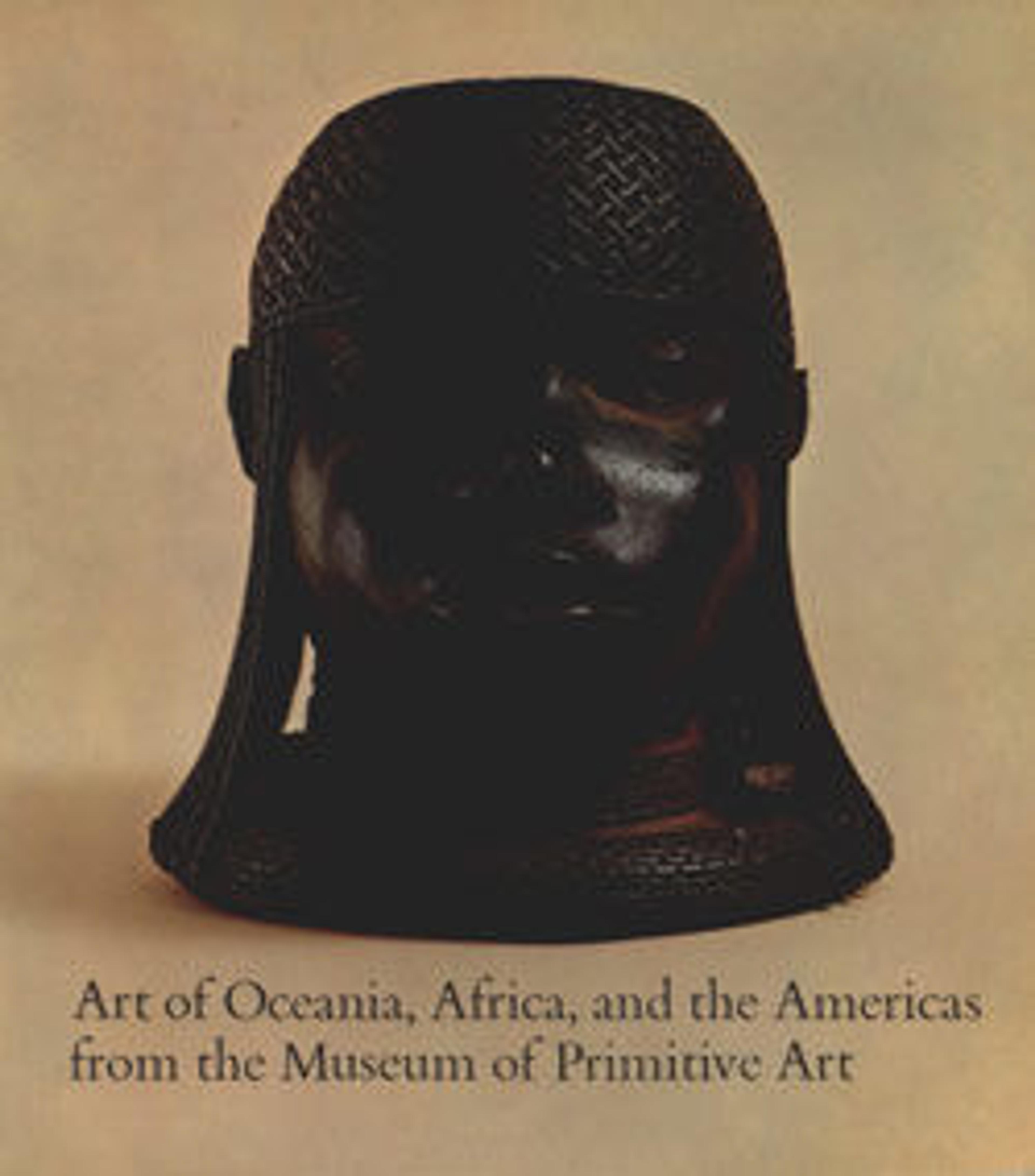Scepter with profile figures
This flint scepter shows two profile faces wearing elaborate headdresses. Maya artists skillfully chipped flint, a fragile and challenging medium, into imaginative multifigure and geometric shapes. The gray-brown source stone retains some of its white cortex at the center of the sculpture. A curled blade forms the bottom portion could have been attached to a wooden handle or staff as an emblem of rulership.
There is evidence that the Maya believed flint (or chert) to have been created when lightning struck the earth, thereby imbuing it with supernatural power. The association of flint scepters and lightning is explicit in this work. The larger of the two figures sits on a wide element with three small appendages that may represent a throne, and the smaller figure extends out from his back, as if being carried. He has foreshortened limbs: a leg that hangs off of the front of the throne, and an arm that extends forward with a gesturing hand. Each profile displays a sloping forehead and a fanned headdress whose distinctive frontal projection probably represents a "smoking celt," the hallmark of K’awiil, the Maya God of Lightning.
The worked flints, created in hundreds of different shapes not corresponding to useful blades, are also frequently found as offerings in Maya tombs or dedicatory caches. Maya flint workers, perhaps working in pairs, used a variety of techniques including direct and indirect percussion as well as pressure flaking with stone, wooden, and bone tools. Some were used as scepters or handheld weapons, as depicted on many stone monuments, and many were also brightly painted with colors before being buried by those who created and commissioned them.
Further Reading
Agurcia Fasquelle, Ricardo, Payson Sheets, and Karl Andreas Taube. Protecting Sacred Space: Rosalila’s Eccentric Chert Cache at Copan and Eccentrics among the Classic Maya. San Francisco, Pre-Columbia Mesoweb Press, 2016.
Easby, Elizabeth Kennedy, and John F. Scott. Before Cortes: Sculpture in Middle America. New York: The Metropolitan Museum of Art, 1970, no. 201.
Pillsbury, Joanne, Timothy F. Potts, and Kim N. Richter, eds. Golden Kingdoms: Luxury Arts in the Ancient Americas. Los Angeles: J. Paul Getty Museum, 2017, no. 143, p. 221.
Schele, Linda, and Mary Ellen Miller. The Blood of Kings: Dynasty and Ritual in Maya Art. Ft. Worth, Kimbell Art Museum, 1986, pp. 73, 83, pl. 26.
Clark, John E., Fred W. Nelson, and Gene L. Titmus, Flint Effigy Eccentrics, in Ancient Maya Art at Dumbarton Oaks, edited by Joanne Pillsbury, Miriam Doutriaux, Reiko Ishihara-Brito, and Alexandre Tokovinine, Washington DC: Dumbarton Oaks, 2012, pp. 273-281.
There is evidence that the Maya believed flint (or chert) to have been created when lightning struck the earth, thereby imbuing it with supernatural power. The association of flint scepters and lightning is explicit in this work. The larger of the two figures sits on a wide element with three small appendages that may represent a throne, and the smaller figure extends out from his back, as if being carried. He has foreshortened limbs: a leg that hangs off of the front of the throne, and an arm that extends forward with a gesturing hand. Each profile displays a sloping forehead and a fanned headdress whose distinctive frontal projection probably represents a "smoking celt," the hallmark of K’awiil, the Maya God of Lightning.
The worked flints, created in hundreds of different shapes not corresponding to useful blades, are also frequently found as offerings in Maya tombs or dedicatory caches. Maya flint workers, perhaps working in pairs, used a variety of techniques including direct and indirect percussion as well as pressure flaking with stone, wooden, and bone tools. Some were used as scepters or handheld weapons, as depicted on many stone monuments, and many were also brightly painted with colors before being buried by those who created and commissioned them.
Further Reading
Agurcia Fasquelle, Ricardo, Payson Sheets, and Karl Andreas Taube. Protecting Sacred Space: Rosalila’s Eccentric Chert Cache at Copan and Eccentrics among the Classic Maya. San Francisco, Pre-Columbia Mesoweb Press, 2016.
Easby, Elizabeth Kennedy, and John F. Scott. Before Cortes: Sculpture in Middle America. New York: The Metropolitan Museum of Art, 1970, no. 201.
Pillsbury, Joanne, Timothy F. Potts, and Kim N. Richter, eds. Golden Kingdoms: Luxury Arts in the Ancient Americas. Los Angeles: J. Paul Getty Museum, 2017, no. 143, p. 221.
Schele, Linda, and Mary Ellen Miller. The Blood of Kings: Dynasty and Ritual in Maya Art. Ft. Worth, Kimbell Art Museum, 1986, pp. 73, 83, pl. 26.
Clark, John E., Fred W. Nelson, and Gene L. Titmus, Flint Effigy Eccentrics, in Ancient Maya Art at Dumbarton Oaks, edited by Joanne Pillsbury, Miriam Doutriaux, Reiko Ishihara-Brito, and Alexandre Tokovinine, Washington DC: Dumbarton Oaks, 2012, pp. 273-281.
Artwork Details
- Title:Scepter with profile figures
- Artist:Maya artist(s)
- Date:600–800 CE
- Geography:Mexico or Guatemala, Mesoamerica
- Culture:Maya
- Medium:Chert
- Dimensions:H. 13 5/8 x W. 7 1/2 x D. 5/8 in. (34.6 x 19.1 x 1.6 cm)
- Classification:Stone-Sculpture
- Credit Line:The Michael C. Rockefeller Memorial Collection, Purchase, Nelson A. Rockefeller Gift, 1967
- Object Number:1978.412.195
- Curatorial Department: The Michael C. Rockefeller Wing
More Artwork
Research Resources
The Met provides unparalleled resources for research and welcomes an international community of students and scholars. The Met's Open Access API is where creators and researchers can connect to the The Met collection. Open Access data and public domain images are available for unrestricted commercial and noncommercial use without permission or fee.
To request images under copyright and other restrictions, please use this Image Request form.
Feedback
We continue to research and examine historical and cultural context for objects in The Met collection. If you have comments or questions about this object record, please contact us using the form below. The Museum looks forward to receiving your comments.
